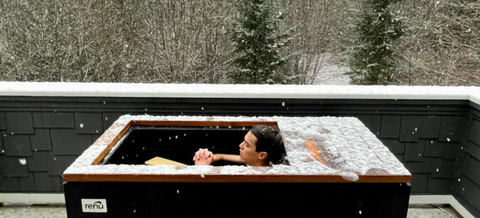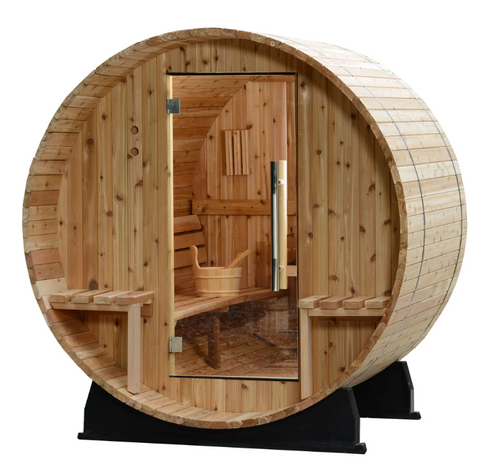Is the hot sauna cold plunge technique right for you?
You may have been hearing more about the hot sauna cold plunge technique recently. If you’re an athlete who’s competitive, you’re likely wanting the most effective recovery method possible. This technique has been shown to improve post-exercise recovery, making contrast therapy a must-have practice for people who want peak performance. By combining hot sauna sessions with cold plunges, people are enjoying an array of impressive health benefits. Aside from the physiological benefits, many contrast therapy practitioners report positive mental health effects as well. If you’re wondering whether you’ll benefit from adding contrast therapy to your daily routine, read on to decide for yourself.
Science-backed health benefits of the hot sauna cold plunge technique
Increased blood flow volume
Switching from hot saunas to cold tubs causes the body to naturally increase the volume of blood flow. This happens when the body naturally constricts and dilates blood vessels. This effect also helps to improve vascular and cardiac response.
Detox your body naturally
Quickly transitioning from a hot sauna to an ice plunge causes your body’s lymphatic system to get started. This system works to flush away toxins throughout your system, promoting cellular regeneration and ridding the body of the harmful byproducts of hard workouts.
Natural skin rejuvenation
The cold plunge stage of contrast therapy makes skin pores rapidly minimize, helping halt oil production that causes skin issues. This can help reduce acne, pimples, blackheads, and even prevent blemishes.
If blemishes are already an issue, contrast therapy is helpful for reducing any swelling and redness to provide soothing relief for irritated skin. Cold exposure is a great way to keep acne from getting worse by effective inflammation reduction.
Optimizes blood circulation
Quickly switching between hot and cold conditions jumpstarts the body’s responses, leading to the alternating between constriction and dilation of blood vessels. Aside from boosting blood flow for higher performance, it also improves vascular and cardiac response.
Flushes lactic acid from muscles
Working out really hard creates lactic acid build-up in the muscles, causing pain and soreness. This painful side-effect can make it tempting to skip the workout. Helping reduce lactic acid pain normally requires rest, plenty of water, and increasing magnesium intake.
We now know that contrast therapy is one of the best ways to quickly reduce lactic acid buildup. Studies have found that contrast therapy can help prevent too much lactic acid buildup, helping people recover from soreness and fatigue faster.
Faster fatigue recovery and enhanced energy levels
One study In 2017 found that alternating between hot saunas and cold plunge tubs helped team sports players recover from fatigue within 24-48 hours of their game. However, it was also found that using an ice bath alone didn’t reproduce these results, indicating hot sauna and cold plunging works better when combined than alone.
Can help prevent DOMS (Delayed onset muscle soreness)
Anyone who has suffered from DOMS knows working out is next to impossible once it sets in. When muscle soreness from intense workouts days earlier happens, it can hurt sports performance and increase the risk of injury. Studies have shown that contrast therapy helps lessen the effects of DOMS, reducing its severity in athletes when regularly practiced.
Helps minimize joint inflammation
When it hurts to move it can be difficult staying on top of your cardio health. Combining time in hot saunas with ice plunges can help reduce painful joint inflammation.
May help reduce the likelihood of Alzheimer’s Disease and dementia
A 20-year, 2,300 participant study by Dr. Jari Laukkanen and his colleagues at the University of Eastern Finland revealed that routine sauna sessions helped lower the chances that participants would suffer from both Alzheimer's disease and dementia.
Are there health risks involved with contrast therapy?
Although in most cases contrast therapy is safe, for some folks it’s too risky. People with pre-existing heart conditions are better off sticking to milder temperatures and avoiding exposure to extreme temperature swings.
When the body’s cold receptors sense a quick drop in temperature, they produce a cardiorespiratory response. This can cause shortness of breath, decreased cardiac output, and a rapid decrease in pulse, all of which should be avoided when cardio health is compromised.
Does the order of hot and cold affect safety?
Immediately jumping into a hot sauna following an ice bath sounds heavenly, but this is actually the worst thing to do when you’re trying to achieve health benefits from contrast therapy.
To be safe and get the full range of health benefits, contrast therapy should always start with a hot sauna session, usually for around 20 minutes. After that, jump into an ice cold tub for three to ten minutes.
Contrast therapy triggers rapid changes in the circulatory system. Therefore, it’s crucial to follow a specific order with contrast therapy to prevent adverse effects.
How often is safe for contrast therapy?
Contrast therapy is most beneficial when performed frequently. Studies have found that more regular and frequent use of contrast therapy is more beneficial in general. These studies have found significant health improvements in people that practice contrast therapy compared with off and on practitioners.
Claim your 5% discount on a RENU contrast therapy combo
RENU hand-crafts cold plunge tubs and hot saunas 100% in the USA. RENU provides you with the ultimate warranty coverage, and we always work to earn 100% customer satisfaction ratings! We offer a beautiful selection of cold plunge tubs and hot saunas to blend with your home's key design elements. All of our contrast therapy products feature exceptional design and build quality that enhances the beauty of any home.Act now for a 5% Discount for a Hot Sauna and Cold Plunge Combo!
















